Leicester Corporation/City Tramways
History
Leicester Corporation obtained powers — under the Leicester Corporation Act of 1897 —to construct a municipal tramway system, and to purchase the town's standard-gauge horse tramway, which was owned and operated by the Leicester Tramways Company. The corporation exercised its right of purchase four years later, taking over the LTCo (including its horse omnibus operations) on the 1st July 1901.
The council seems to have been in no hurry to have its new electric tramway, instead setting the horse tramway in order (discipline was apparently lacks and maintenance had been neglected) and purchasing a number of second-hand vehicles to supplement those it now owned.
The council then spent an inordinate length of time deciding which lines to build and more perniciously, hand-wringing over the precise form of traction they wished to use. Like many towns the length and breadth of the kingdom, civic luminaries and prominent local figures were outraged by the thought of their town being disfigured by unsightly overhead wires. The council therefore set up a sub-committee to investigate the alternatives to overhead current collection (including conduit, battery, cable and surface-contact); however, when the resulting report recommended overhead electric traction, the council found itself in a quandary, which it hoped to extricate itself from by commissioning a second report, this time from an independent expert. Ironically, this not only cost the council yet more time and money, but then produced precisely the same recommendation. Although the opposition faction were still unhappy, they were eventually brought into line by the cost of their favoured alternative — conduit collection — which would have bumped up the overall price for the new tramway system to £1 million, over 50% more than for overhead current collection.
As a result of all the wrangling and indecision, work on the new tramway and conversion of the existing horse lines did not start until early 1903, though on the plus side, the long gestation period was used to good effect by those tasked with designing and equipping the tramway, the resulting system being well-conceived, and constructed to a very high standard. Construction took over a year, the first electric services commencing on the 18th May 1904, and the last horsecar service running five months later on the 31st October 1904.
The system, as initially envisaged, was completed on the 8th June 1905 with the opening of the line to Melton Road, which was an immediate success, twenty additional tramcars being ordered that year to meet the demand. The LCT gained a deserved reputation for efficiency and for maintaining the system to a high standard, which of course required continual investment. The tramcar fleet was open-topped, and work was put in hand in 1912 to top cover them, eventually all bar six tramcars out of a substantial fleet being modified, though it would take to the mid-to-late 1920s to achieve this. Whilst further tramcars were purchased in 1913/14 and again in 1920, they could hardly be described as modern from a design perspective, which seems a little at odds with the department's general approach to the tramway as a whole.
Although powers were obtained in 1913 to build a series of ambitious extensions, the Great War intervened, the only lines built being along King Richards Road (opened on the 15th September 1915) and an extension along Welford Road to Clarendon Park, which though started prior to the war, was not finally opened until September 1922.
As with most systems, the LCT was place under tremendous strain during the Great War, with men (and skills) lost to the armed services, and severe restrictions on the purchase of new hardware and in the availability of spares. As a consequence, maintenance was kept to the minimum practicable, the system emerging from the conflict in badly run-down condition. Passenger numbers reached a peak in 1919, and it is clear that the corporation viewed its tramway as a municipal asset to be proud of, and one that would be resourced properly. Investment therefore flowed into the tramway, worn-out track being replaced, new tramcars purchased and a significant programme of tramcar refurbishment/rebuilding undertaken; if it hadn't have been for post-war procurement difficulties, it is likely that significantly more new lines would have been built than eventually were.
The year 1919 also saw the town granted city status, the fleet and department name being changed from 'Leicester Corporation Tramways' to 'Leicester City Tramways'.
A section of reserved track formation was opened along Blackbird Road and Abbey Park Road in June 1924, with the last extension of all — a branch off the Humberstone Road line to Coleman Road — opening in March 1927, taking the tramway to its final size of 22.74 miles. The tramway system essentially comprised eleven lines radiating from the Clock Tower, along with a number of connecting lines between them. Lines ran: northeastwards along Belgrave Road, before splitting, one running northwards along Loughborough Road to Belgrave and the other continuing northeastwards along Melton Road to its junction with Sandringham Avenue; eastwards along Humberstone Road to a terminus at its junction with Humberstone Drive, with a branch leading off southwards along Coleman Road to Green Lane Road; southeastwards along London Road to Stoneygate, with two connecting lines running northwards to join the Humberstone Road line, one via Melbourne Road and the other via East Park Road; southwards along Welford Road to Clarendon Park, with a line branching off southwestwards along Aylestone Road to Aylestone, and a connecting line running northeastwards from Clarendon Park along Clarendon Park Road to join the Stoneygate line; southwestwards along Narborough Road to a terminus at its junction with Harlaxton Street; eastwards along Hinckley Road to Weston Park; northwestwards via Great Central Street and Woodgate to Groby Road, at its junction with Garland Crescent, with two connecting lines, one running northwards along Blackbird Road and Abbey Park Road to join the Belgrave Road route, and the other running southwards along Fosse Road North to join the Groby Road line, with yet another connecting line running eastwards from Fosse Road along King Richards Road towards the Clock Tower.
In order to meet the demand from the city's growing population, many of whom were not served by the tramway system, the corporation decided to experiment with motorbus operation, the first service commencing on the 24th July 1924. The motorbuses were an immediate success, with services being expanded (and new vehicles purchased) throughout the remainder of the 1920s and into the 1930s. Although the tramway remained at the core of the LCT's transport services, and had received significant investment throughout the 1920s, the success of the motorbuses inevitably meant that a good, hard look would be taken at the cost of replacing worn-out tramway infrastructure as and when it became due. The first casualty was the Melbourne Road line, which closed in 1933, the cost of replacing 18 sets of points on this single-line-with-passing-loops route proving prohibitive when compared with purchasing the necessary number of replacement motorbuses.
In 1935, the enterprise's name was changed — to Leicester City Transport — to better reflect the services offered, by which time pressure was building to replace the entire tramway with what were regarded, at the time, as more modern forms of transportation. The council was divided into two camps, pro-motorbus and pro-trolleybus, the corporation's electricity department not unnaturally supporting a switch to trolleybus operation. Like many other medium-sized towns around the country, there seems to have been little appetite for a tramway modernisation programme similar to those carried out in the bigger cities such as Leeds and Glasgow, as no assessment of this was made.
The next major route to close was the Coleman Road branch — on the 23rd October 1938 — which was in fact the newest line, followed on the 2nd April 1939 by the King Richards Road line. More lines would no doubt have followed in the early 1940s but for the war, closures being temporarily halted. As the outcome of the war became clear, the corporation restarted the abandonment, the Welford Road line closing on the 1st May 1945. It was, however, to be another four years before the system finally closed, the slow run-down being in large part due to problems procuring new buses in the immediate post-war years. Leicester's last electric tram of all ran —on the Humberstone Road line — on the 9th November 1949.
The municipal tramway had been a resounding success, well-regarded and very profitable; much of its expansion and renewal was funded out of reserves and revenue rather than borrowing, and all the while it subsidised the Electricity Department, and therefore the corporation, through the levying of excessive charges for power consumption.
Uniforms
Following its takeover of the Leicester Tramways Company on 1st July 1901, the corporation operated horse trams for just over three years. The corporation appears to have continued the practice of the company, requiring drivers and conductors to wear reasonably smart attire (jackets, shirts and ties) rather than issuing uniforms. Whilst drivers appear to have worn the normal headgear of the day, principally flat caps, conductors seem to have been provided with soft-topped peaked caps, though these could equally well have been self-purchased. Whether these caps carried any kind of insignia is impossible to say, though photographs would suggest not.
Photographs taken following the inauguration of electric services show staff wearing double-breasted jackets with three pairs of buttons and lapels; the collars carried an employee number on the bearer's left-hand side in individual metal numerals, almost certainly brass. Headgear took the form of tensioned-crown peaked caps; these bore a municipal wyvern badge, which was worn above a standard, off-the-shelf, script-lettering grade badge, either 'Motorman' or 'Conductor'. The latter badges appear to have largely fallen out of use shortly before to the Great War, probably around 1912/13, though some individuals continued to wear them right through to 1919.
During 1919, or shortly thereafter, and following the grant of city status to Leicester, the name of the enterprise was changed from 'Leicester Corporation Tramways' to 'Leicester City Tramways'. This was eventually reflected in the issuance of a new cap badge, which took the form of a brass oval inlaid with blue enamel. This bore an employee number in the centre, with 'CITY OF LEICESTER' and the employee's grade (either 'CONDUCTOR' or 'DRIVER') around the outside. A separate municipal-device badge was attached to the top of the main badge (see below); the municipal-device badge included lion supporters, which were not officially granted until 1926, suggesting that the badges were first issued around this date. The badges were very probably changed to chrome in the late 1930s or 1940s, as chrome tramway buttons were also issued (see link).
Given that the name of the undertaking was changed in 1935, it is likely that issues of new uniforms after this date bore 'Leicester City Transport' buttons.
Staff were also issued with double-breasted greatcoats with five pairs of buttons and high, fold-over collars; the latter bore an employee number in individual brass numerals, once again, on the left-hand side only.
In the Edwardian era, inspectors wore double-breasted jackets with lapels; the latter carried elaborate embroidered 'LCT' initials, though probably only on the left-hand side. Caps were of the tensioned-crown peaked type, and existed in two varieties, one using fairly standard cap material, the other with a woven-straw crown, the former presumably for winter wear and the latter for summer wear. Both styles of cap bore the grade — 'Tramways Inspector' — in embroidered script lettering on a hat band of a contrasting colour, along with a braided chin strap. Early photographs show that a municipal wyvern badge was also worn on the cap, just under the crown, though it clearly fell out of use in later years. Edwardian inspectors were also issued with long, double-breasted overcoats with five pairs of buttons (the top pair buttoning between the lapels and the collars), three waist-level pockets (with flap closures) and a open breast pocket; the collars bore system initials — 'LCT' — in embroidered script lettering.
Although inspectors' uniforms undoubtedly changed in later years, photographic evidence of this is currently lacking. A studio portrait has, however, survived of a Tramways Motor Inspector (see below), which was probably taken shortly after the Great War or in the early 1920s. The uniform is very similar to that worn by Edwardian inspectors, except that the 'LCT' initials were carried on the right-hand collar only, with braiding on the glossy peak, along with 'Tramways Motor Inspector' in embroidered script lettering.
In common with many tramway operators, Leicester employed female conductors during the Great War to replace men lost to the armed services, the last of them leaving in October 1919. The conductresses were issued with tailored, single-breasted jackets with four pockets (two waist and two breast pockets, the latter with button closures) epaulettes and lapels; the collars carried embroidered 'LCT' initials on the bearer's right-hand side, and possibly on the left-hand side too. Three styles of hat are known: a wide-crown peaked cap and felt bonnets, the latter with and without light-coloured piping; the bonnets were sometimes worn with one side pinned up, Australian slouch hat fashion. Whether the caps and bonnets reflect winter and summer wear, or the replacement of one style by the other, is currently unknown. Both, however, bore a hat band upon which an employee number (in brass numerals) was carried. The ladies were also issued with long, double-breasted topcoats with lapels and epaulettes; these were piped, but bore no insignia.
Female staff were also employed in considerable numbers during the Second World War, and right up until closure of the system in 1949. They were provided with tailored, single-breasted jackets with four buttons, four pockets, lapels and epaulettes, along with matching trousers; it is currently unclear what insignia were carried on the jackets. Headgear is even less clear, but appears to have taken the form of a military-style peaked field cap, though confirmation must await the discovery of better photographic evidence.
Further reading
For a largely pictorial history of the system, see: 'Leicester's Trams' by Geoff Creese; Irwell Press (2000).
Images
Horse tram drivers and conductors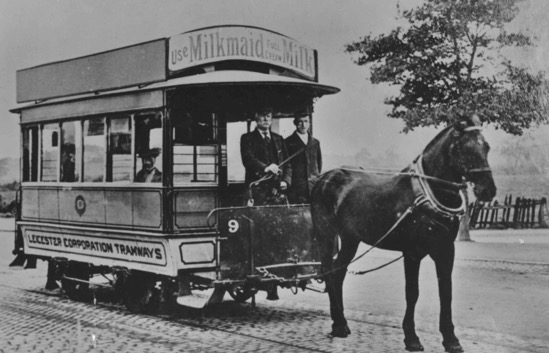
A nice study of the driver and conductor of Horsecar No 9 at the Groby Road terminus in 1902. Photo courtesy courtesy of the National Tramway Museum. 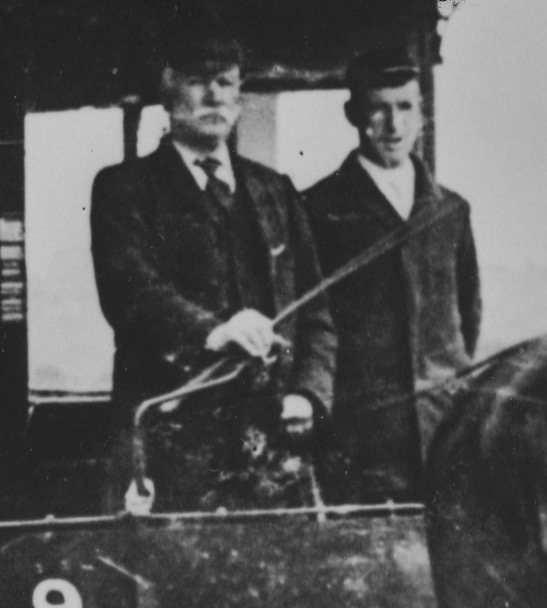
An enlargement of the above photograph, which suggests that neither man is wearing a uniform, though both have tight-fitting peaked caps.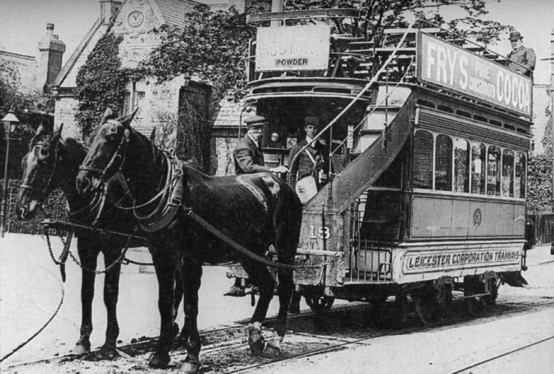
A driver and a conductor with Horsecar No 18 at the Belgrave terminus — photo undated, but certainly taken after the corporation takeover in July 1901 as the vehicle carries the new system title in full. Photo courtesy of the Tramways and Light Railway Society, with thanks to David Voice.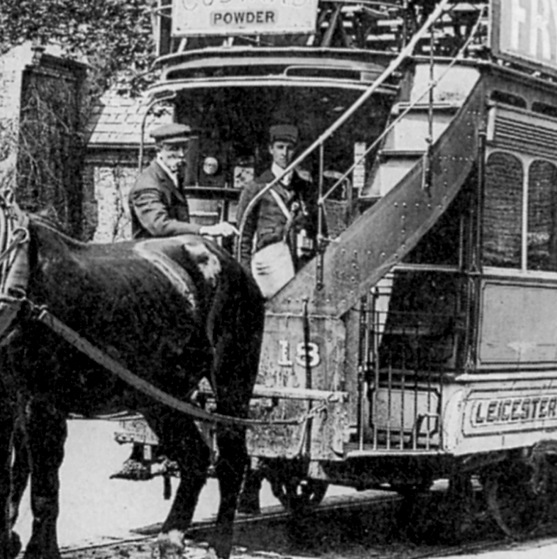
An enlargement of the above photograph showing the driver (in large flat cap) and the conductor, who may be wearing a kepi, though this is difficult to say with any degree of certainty. 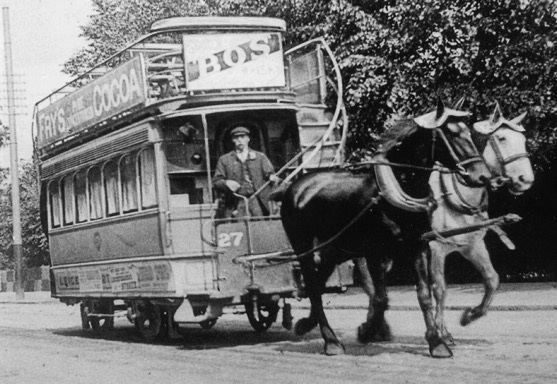
A rare 'in motion' shot showing the driver of Horsecar No 27 — photo undated, but certainly taken after July 1901. Photo courtesy of the Tramways and Light Railway Society, with thanks to David Voice.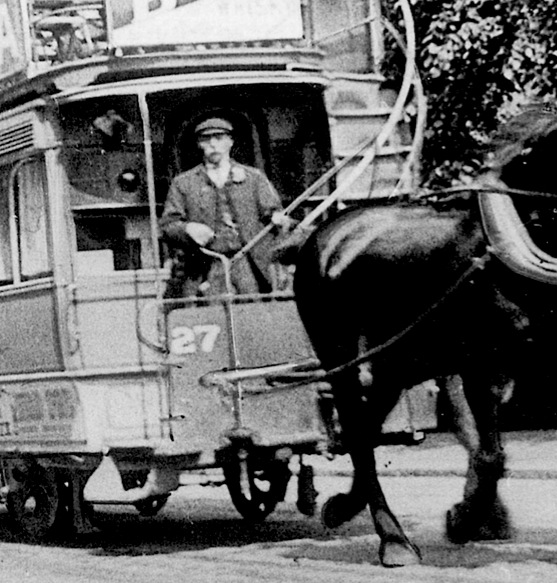
An enlargement of the above photograph, once again showing that the driver is wearing a flat cap.
Motormen and conductors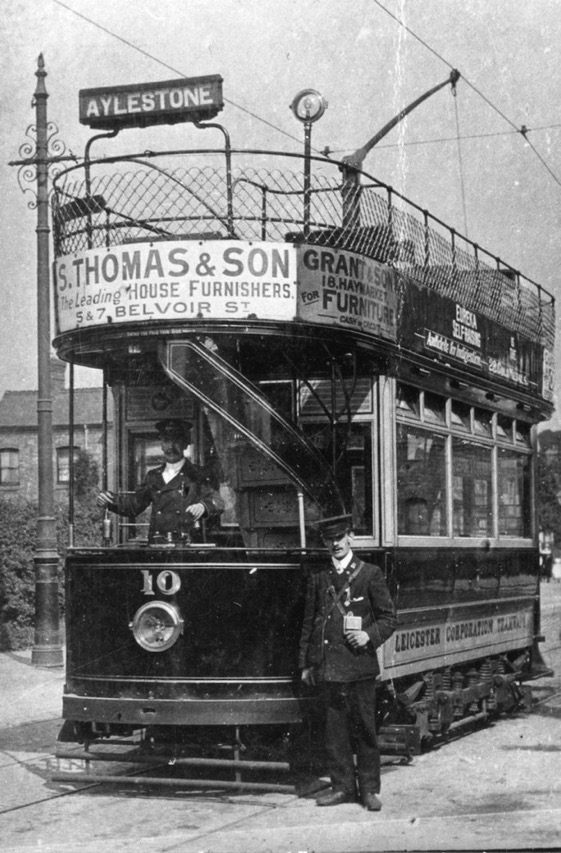
The crew of what appears to be a virtually brand-new Tramcar No 12 (dating the photograph to late 1904 or early 1905) pose for the camera at what is possibly the terminus at Aylestone. Author's Collection.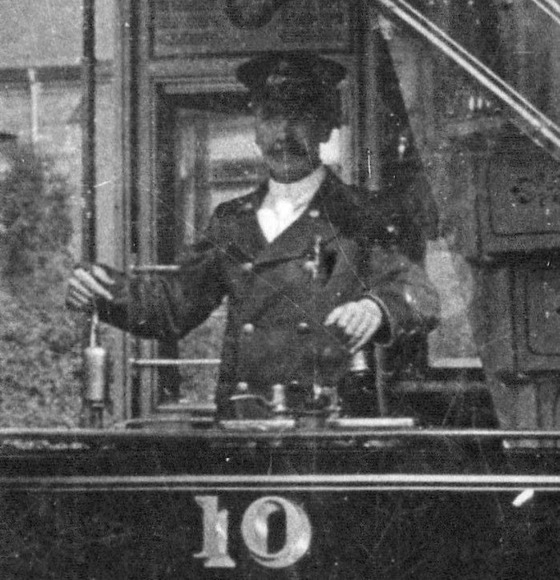
An enlargement of the above photograph showing the motorman, who is wearing a smart double-breasted jacket with lapels, along with white shirt and tie or possibly a cravat. His tensioned-crown peaked cap carries a script-lettering cap badge — 'Motorman' — above which a small municipal wyvern badge can just be made out.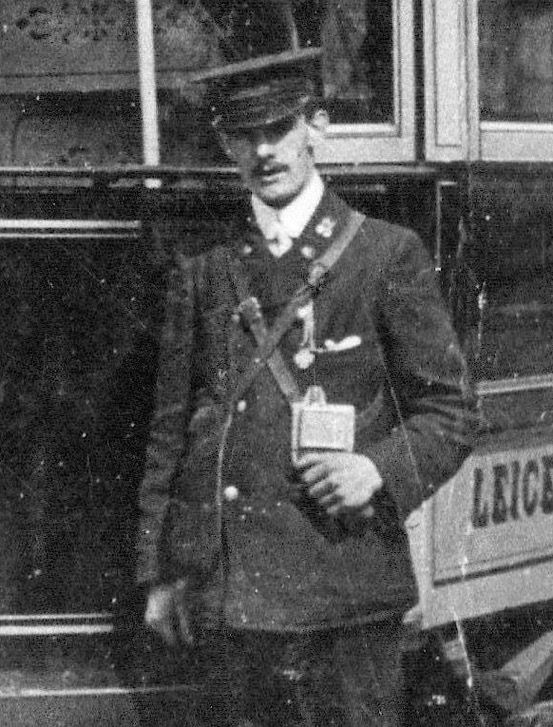
Another enlargement of the photograph above, this time showing the conductor, Employee No 32.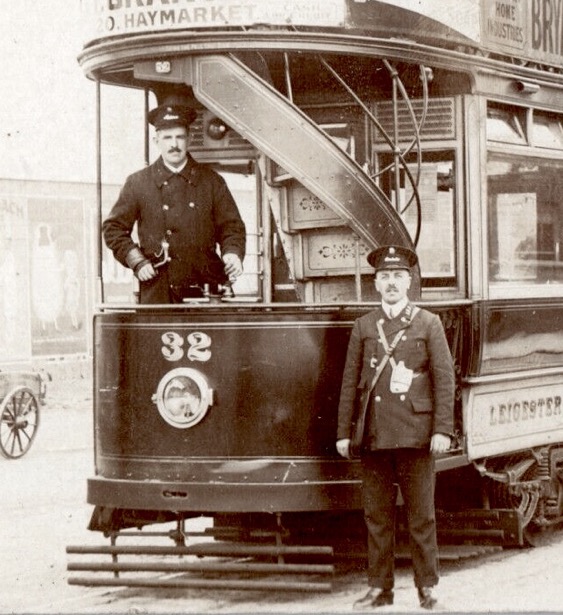
Another shot of a virtually brand-new tramcar, this time No 32, dating the photograph to 1904/5. Both men are wearing script-lettering grade badges — 'Motorman' and 'Conductor' — beneath a small cap badge, which other photographs clearly show to be the Leicester wyvern.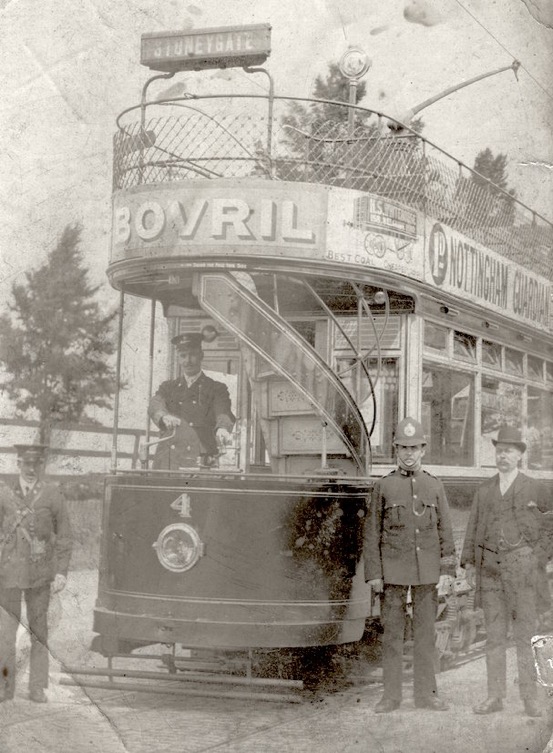
Another photograph of what appears to be a new, or nearly new vehicle, this time Tramcar No 4. Photo courtesy of the Richard Rosa Collection.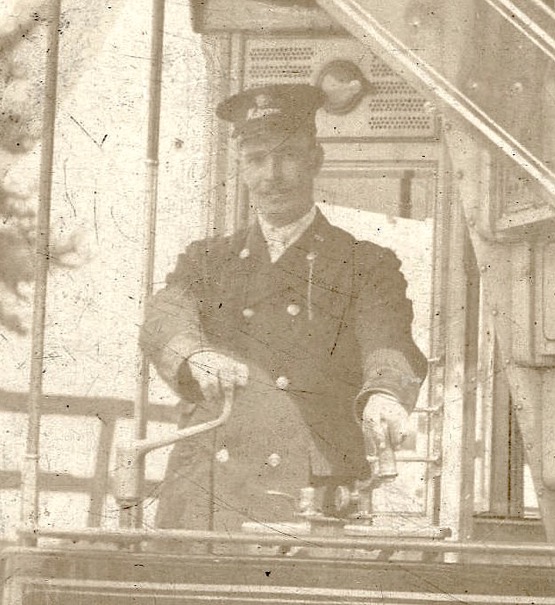
An enlargement of the above photograph showing the motorman (possibly Employee No 9). His script-lettering grade badge can just be made out, as well as the general shape of the wyvern badge.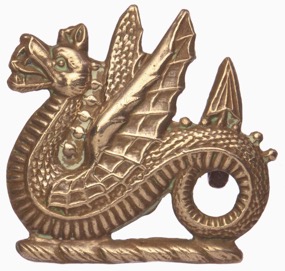
Leicester wyvern cap badge — brass — almost certainly the pattern used by Leicester Corporation Tramways from 1904 to the 1920s. Whilst the badge is very similar to the well-known Midland Railway Company wyvern badge, which was used by Burton & Ashby Light Railways, there are clear differences in both the wings and the tail (see link).
General pattern script-lettering grade badges — 'Motorman' and 'Conductor' — of the type used by Leicester Corporation Tramways on tramcar crew caps; brass. Early photographs clearly show these badges, whereas on later ones they are absent, suggesting that they fell out of use around the time of the Great War.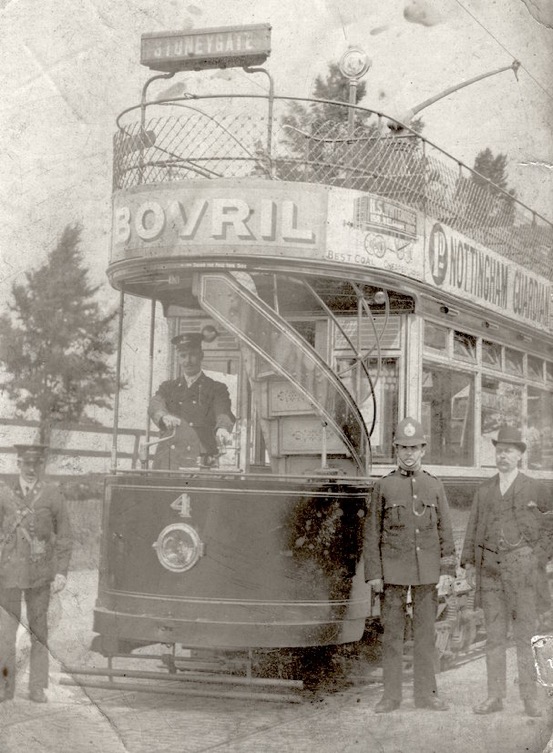
Another photograph of what appears to be a new, or nearly new vehicle, this time Tramcar No 4. Photo courtesy of the Richard Rosa Collection.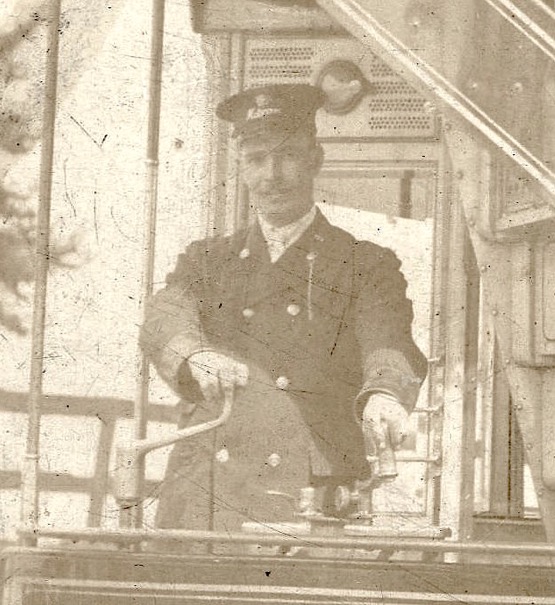
An enlargement of the above photograph showing the motorman (possibly Employee No 9). His script-lettering grade badge can just be made out, as well as the general shape of the wyvern badge.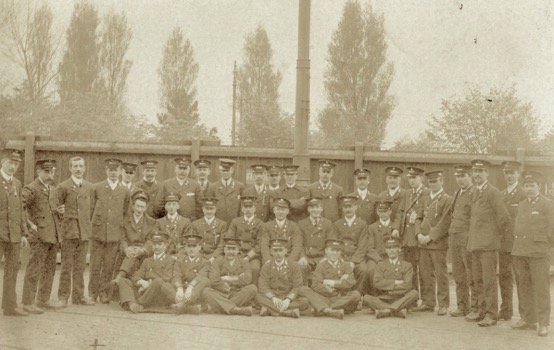
A group of LCT motormen and conductors at what is probably Abbey Park Road depot, many in white shirts and white ties/cravats — photo undated, but probably mid-Edwardian. Author's Collection.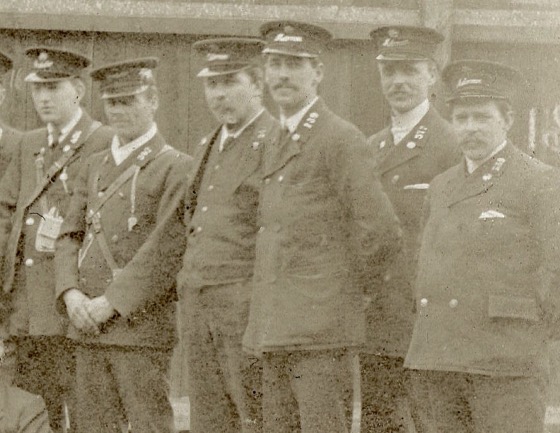
An enlargement of the above photograph showing a few of the assembled conductors and motormen.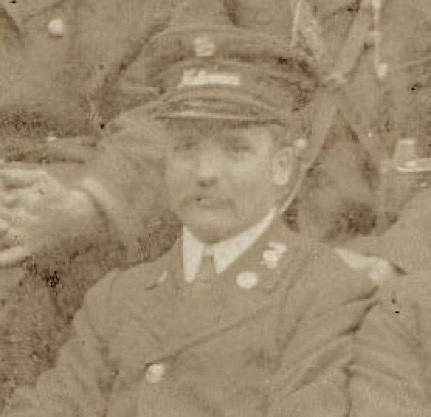
Another blow-up of the above photograph showing a motorman, the shape of the wyvern badge just about being discernible.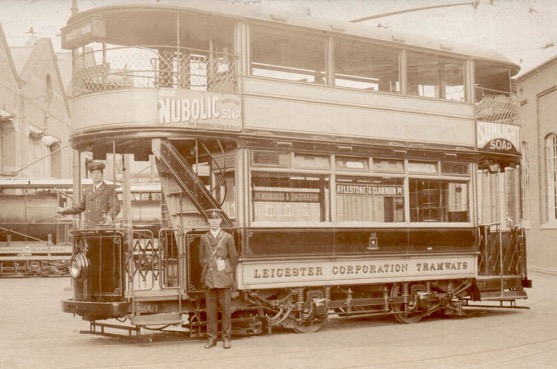
A depot photograph of what would appear to be a newly top-covered and outshopped Tramcar No 141, dating the photograph to 1912/1913.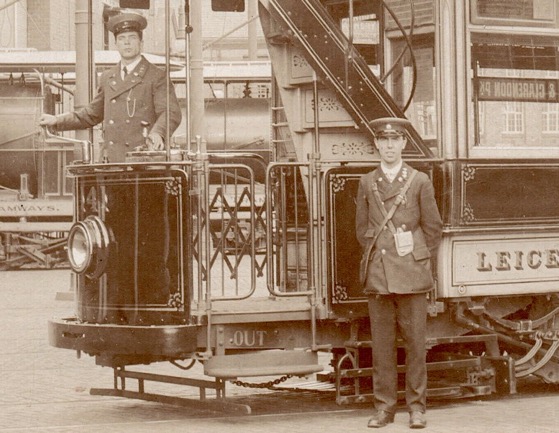
An enlargement of the above photograph showing the motorman and conductor, both of whom are wearing the same style of uniform, but lacking the script-lettering grade badges.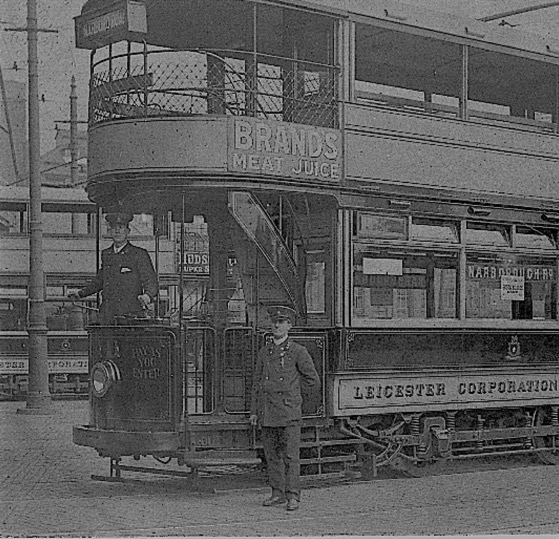
Another shot of Tramcar No 141 and its crew, but this time slightly later, in 1913. The vehicle is still in excellent condition, but is now marked up for 'Pay As You Enter' working. Both men are still wearing the same style of uniform seen in the preceding photograph, but once again lacking the script-lettering grade cap badges. Photo courtesy of Steve Foxon.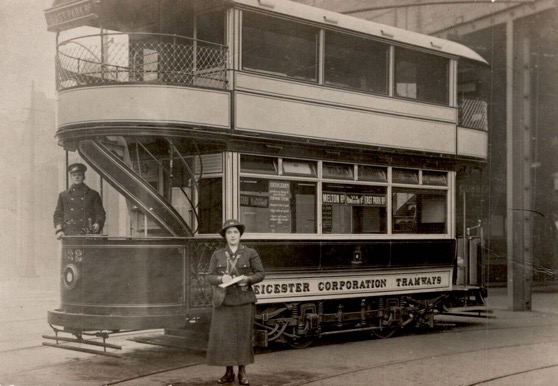
Tramcar No 132, probably newly outshopped, stands with its crew at Abbey Park Road depot during the Great War.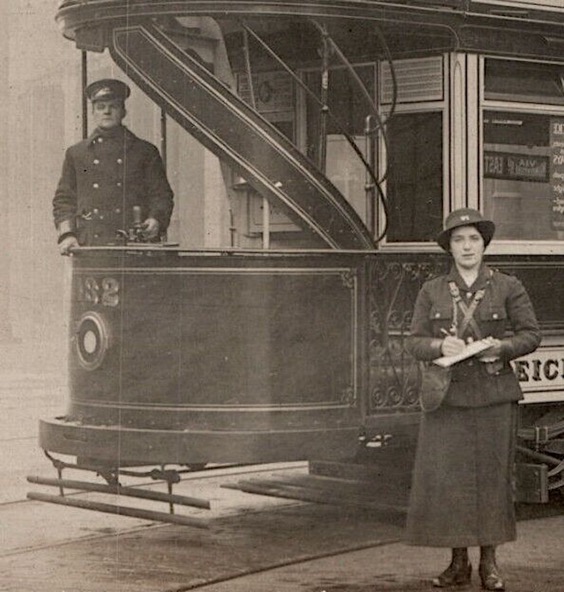
An enlargement of the above photograph showing the motorman and the conductress, the former in a double-breasted greatcoat, and with a cap that bears a script-lettering grade badge.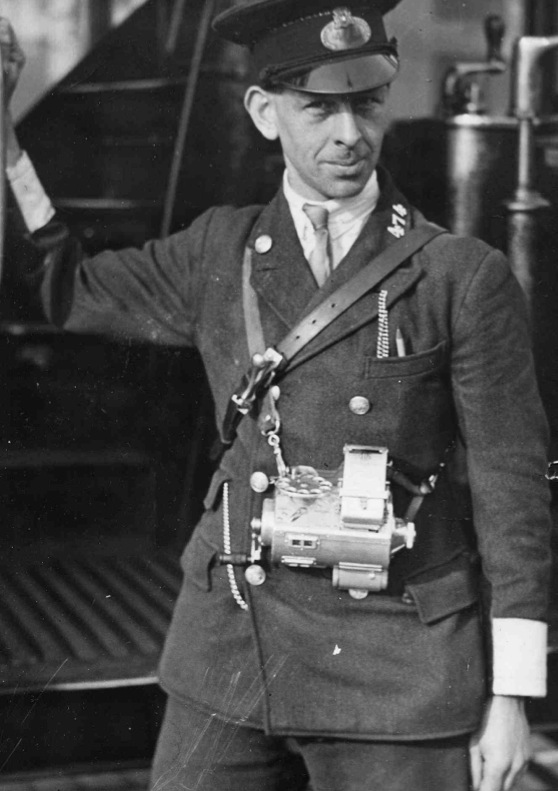
Leicester City Tramways Employee No 474, Hubert Marvin — photo undated, but probably taken just before or just after the Second World War. Photo with kind permission of the Leicester Transport Heritage Trust.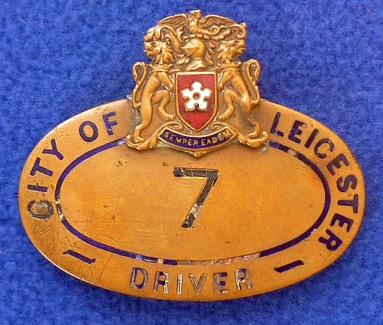
Driver cap badge (mid-1920s to 1930s) — brass and blue enamel. Author's Collection.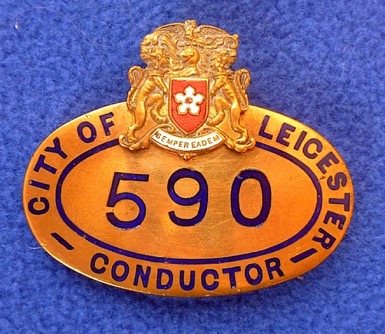
Conductor cap badge (mid-1920s to 1930s) — brass and blue enamel. Author's Collection.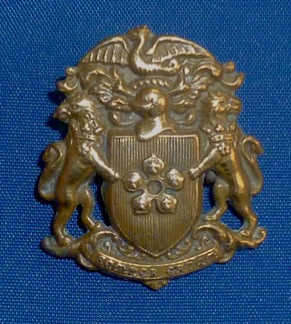
Possible Leicester Corporation Tramways collar badge — brass. The fact that the supporters to the arms were not granted until 1926, suggests that the badge post-dates this. Whether it was used on LCT uniforms is unclear. Author's Collection.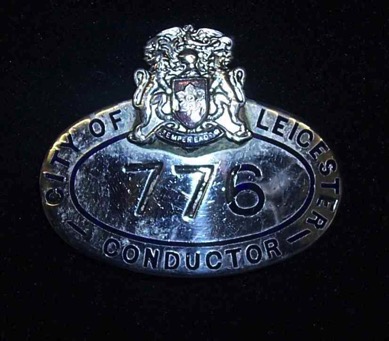
Conductor cap badge (1930s/1940s onwards) — chrome and blue enamel.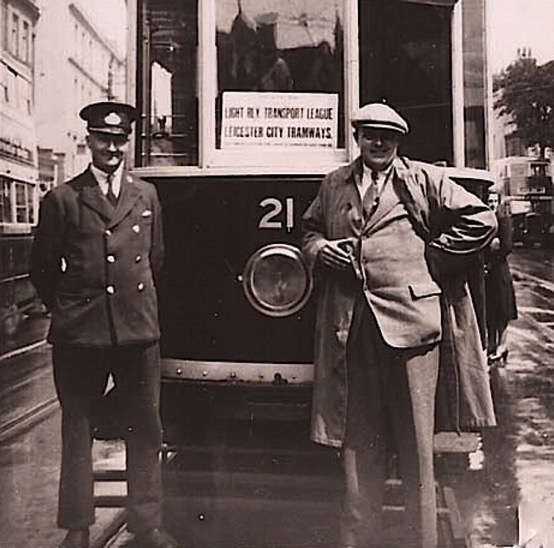
A motorman stands in front of Tramcar No 21 on a Light Railway Transport League tour — photo undated, but probably taken shortly after the Second World War (No 21 was withdrawn in 1949). Stephen Howarth Collection.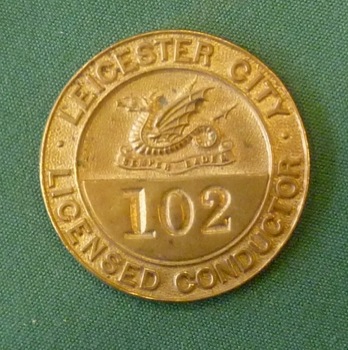
Leicester Corporation 'CONDUCTOR' licence No 102 — brass. This may have been worn by tramway staff at some point, though photographic evidence would suggest not. With thanks to John Burford.
Senior staff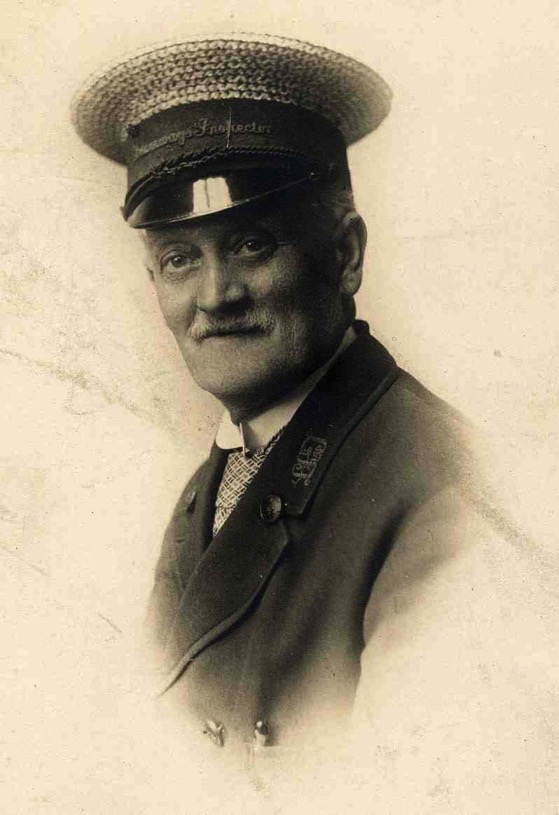
An LCT inspector in what appears to be his summer uniform — photo undated, but almost certainly taken in the early Edwardian era. With kind permission of the Leicester Transport Heritage Trust.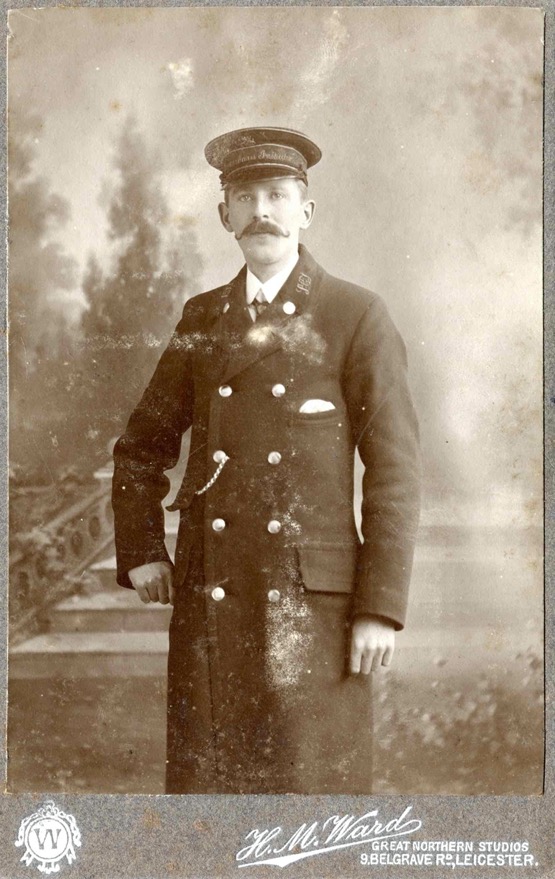
Leicester Corporation Tramways Inspector Horace Valentine Ansell — photo undated, but probably taken in the mid-Edwardian era. Inspector Ansell was born in Burton upon Stather in Lincolnshire, and worked on the railways in Leeds until about 1903 when he moved to Leicester. He is listed in the 1911 census as a Tramways Depot Inspector, and he was still an inspector at the age of 63 years in 1939, so appears to have worked for the LCT for the remainder of his working life. Photo and background information courtesy of his great niece, Sheila Hamilton-Dyer.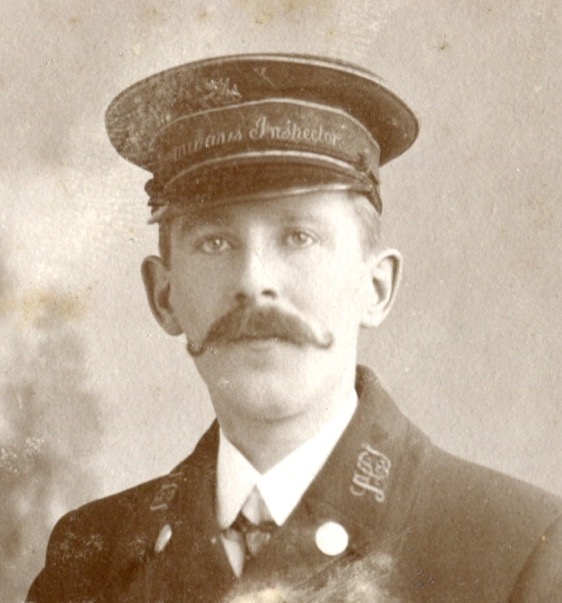
An enlargement of the above photograph showing details of the cap and collar insignia. As well as the embroidered grade, his cap also bears a municipal wyvern badge.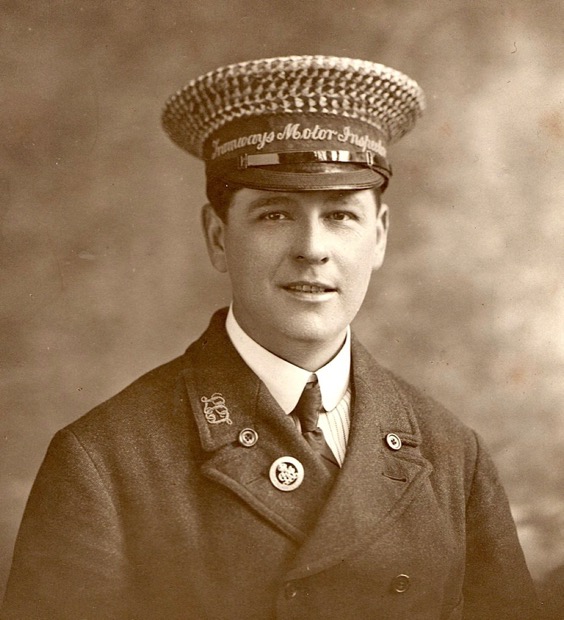
LCT 'Tramways Motor Inspector' — photo undated, but probably taken during or shortly after the Great War, given that he wearing a Silver War Badge on his right lapel; these were issued to soldiers who had been honourably discharged due to wounds or illness. Author's Collection.
Female staff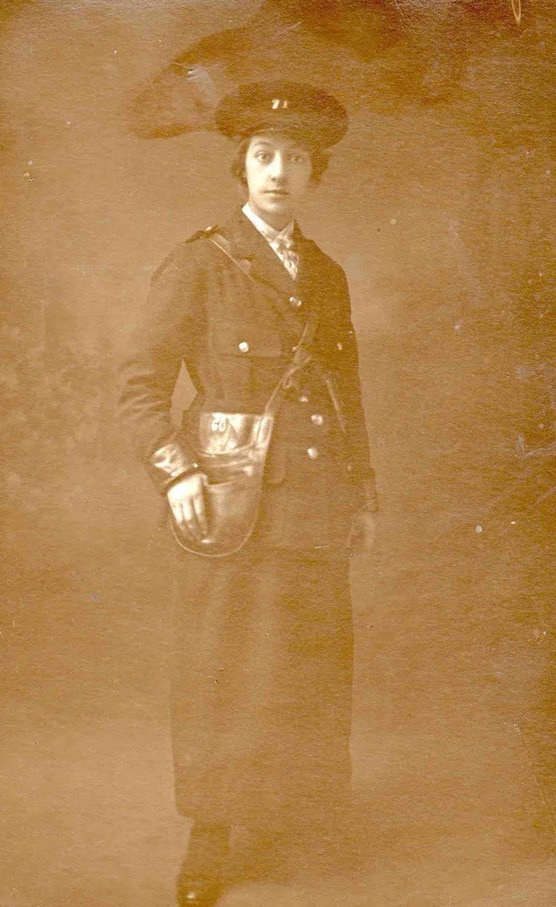
A studio portrait of a Great War LCT conductress, taken by 'Arthur Bee, Photographer 314, Western Rd, Leicester'. The subject is wearing a tailored, single-breasted jacket, seemingly without metal insignia of any kind, and a wide-crown peaked cap. Her cash bag bears the number 60. Author's Collection.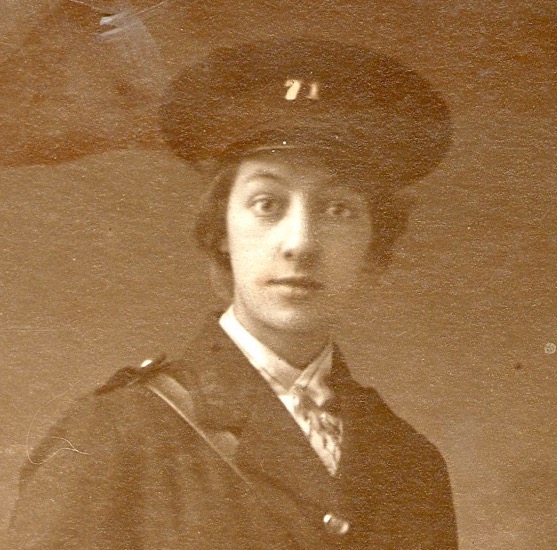
An enlargement of the above photograph showing details of the uniform. The collar bears embroidered 'LCT' initials, whilst the cap bears an employee number, 71. She is also wearing a white cravat, an item worn by many male staff, and seemingly a peculiarity of the LCT.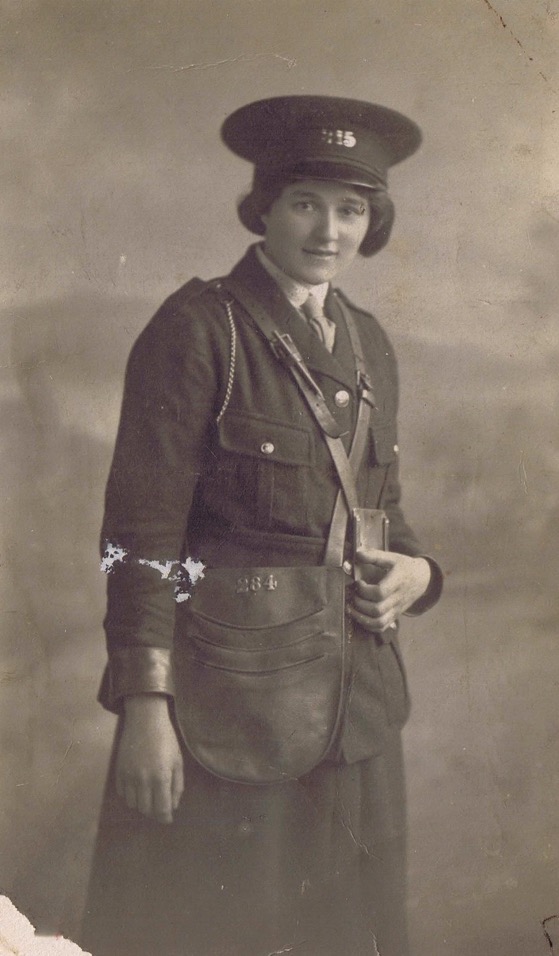
Great War LCT Conductress No 215 Ethel Bexon (née Thorpe). She was born on the 10th October 1895 in Burton Pedwardine in Lincolnshire, and married Samuel Bexon in Leicester in 1917; as she is not wearing a wedding ring, the photo was presumably taken before her wedding, i.e., in 1916 or 1917. Photograph and background information courtesy of Philip Sugden, Ethel's grandson.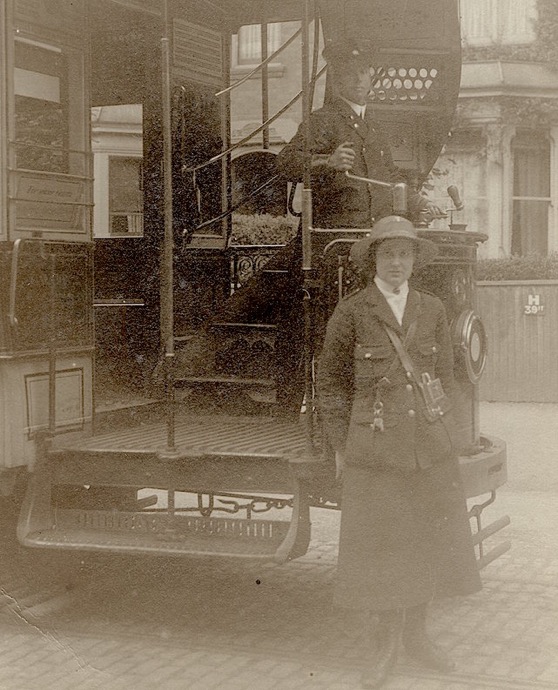
An LCT motorman and a conductress with a tramcar in the 60s series — photo undated, but almost certainly taken during or shortly after the Great War. The conductress is wearing a bonnet with a hat band bearing what is, in all probability an employee number, along with the distinctive white cravat. Author's Collection.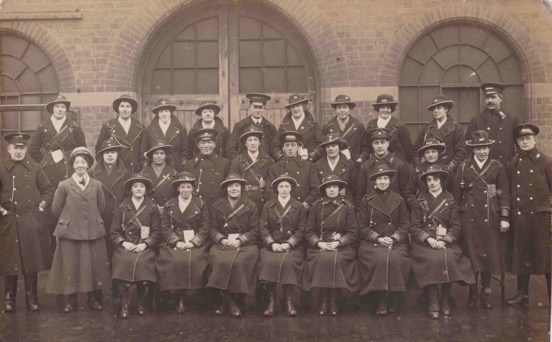
A group of conductresses assembled at Abbey Park Road depot during the Great War. Author's Collection.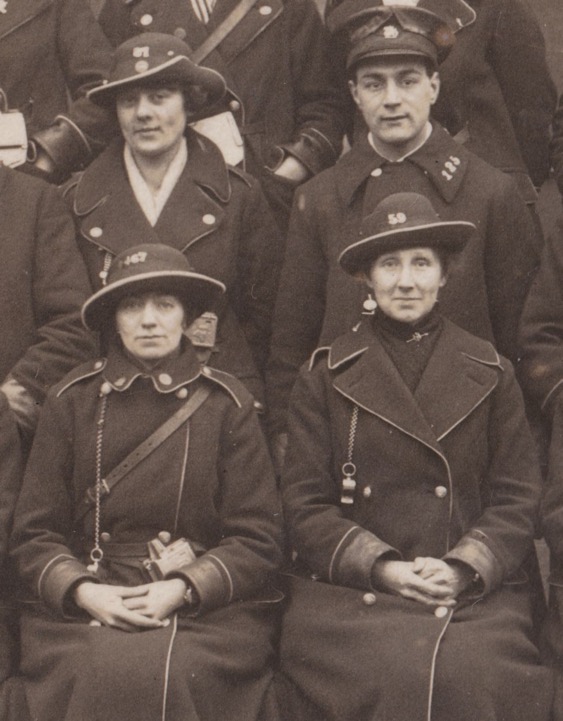
An enlargement of the above photograph showing a motorman (with wyvern cap badge) and three of the conductresses, who are wearing piped double-breasted topcoats (unmarked) and felt bonnets (bearing an employee number). Although only one lady in this enlargement is wearing a white scarf, this isn't representative of the bigger picture, where the majority of ladies are wearing them.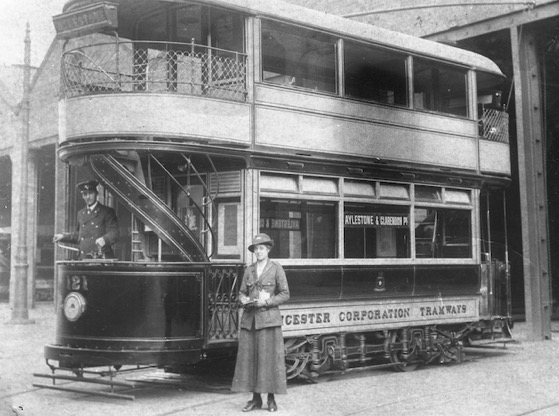
A motorman and a conductress pose with Tramcar No 121 outside Abbey Park Road depot — photo dated 1916. Photo courtesy courtesy of the National Tramway Museum. 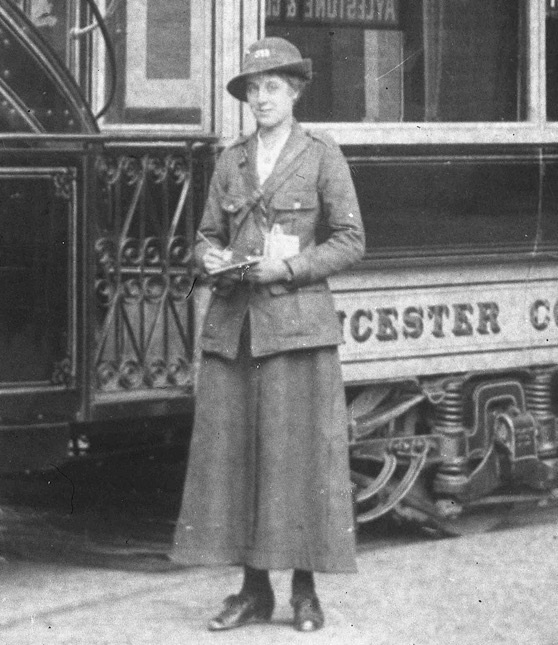
A n enlargement of the above photograph showing the conductress.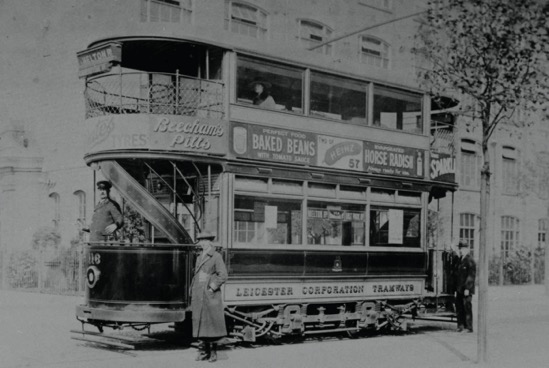
Tramcar No 116 with motorman and conductress — photo undated, but certainly taken during the Great War. Photo courtesy courtesy of the National Tramway Museum. 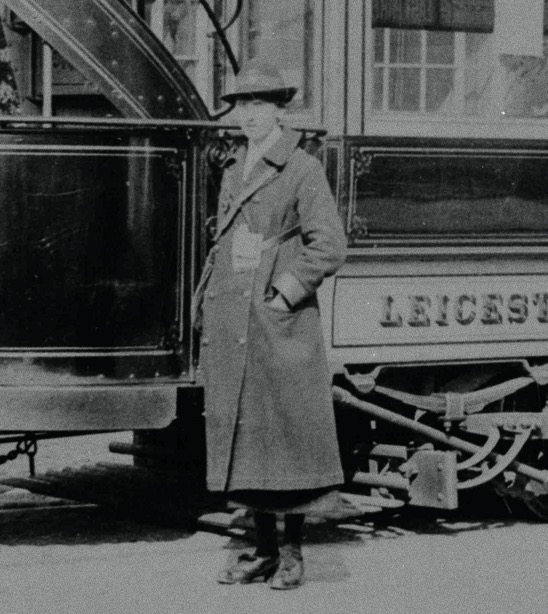
An enlargement of the above photograph showing the conductress, who appears to be wearing a heavy-duty greatcoat.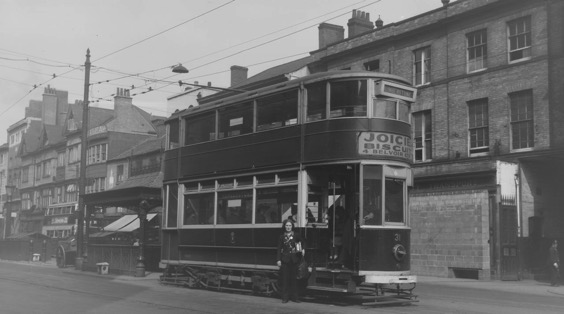
An LCT conductress poses for the camera in front of Tramcar No 31 outside the Bell Hotel at the Humberston Gate terminus on the 21st May 1943. Photo by G F Cunningham, courtesy of the National Tramway Museum. 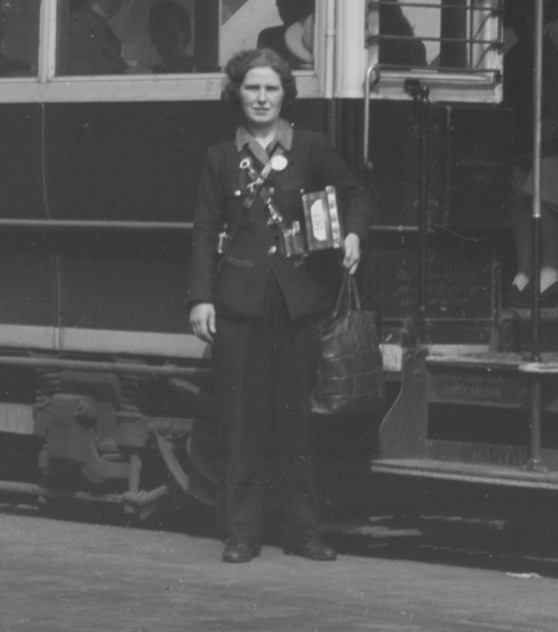
An enlargement of the above photograph showing the conductress. She is wearing a single-breasted jacket with lapels and matching trousers. Given that she is wearing a round PSV badge, she almost certainly worked on the buses as well.